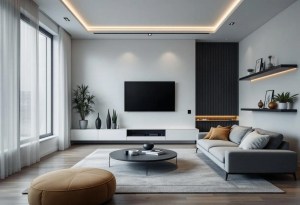For years, the construction industry has been stuck in its ways. Traditional building methods, while reliable, often lead to delays, ballooning costs, and a hefty environmental footprint. But there’s a game-changer on the horizon: modular construction. As an architect passionate about sustainability and efficiency, I’ve witnessed firsthand how modular techniques are poised to revolutionize the way we build.
Modular Construction: Building Blocks for the Future
Imagine building with giant LEGOs. That’s essentially modular construction. It involves creating building components in a controlled factory setting and then assembling them on-site. These modules can be entire rooms, building sections, or even complex structural elements. This prefabrication process unlocks a range of benefits that traditional construction simply can’t match.
From Sears Kits to Modern Marvels: A Quick History
Believe it or not, modular construction isn’t exactly new. Sears, Roebuck and Co. famously sold mail-order kit homes in the early 20th century. But modern modular construction has come a long way since then. Thanks to advances in materials science and digital design, we can now create incredibly sophisticated and complex modular structures. From affordable housing to towering hotels, the possibilities are practically endless.

The Power of Smart Tech: BIM, Automation, and Robotics
Smart technologies are fueling the modular revolution. Building Information Modeling (BIM) allows architects and engineers to create detailed 3D models of modular components, ensuring a perfect fit. Automation and robotics streamline the manufacturing process, boosting efficiency and cutting down on errors. This digital precision translates to faster construction times and lower costs on-site. It’s all about working smarter, not harder.
Building Green, Block by Block: The Sustainability Advantage
As an advocate for environmentally conscious design, I’m particularly excited about the sustainability benefits of modular construction. Here’s why it’s a greener approach:
- Less Waste: Factory environments minimize material waste thanks to precise measurements and cutting techniques.
- Eco-Friendly Materials: Modular construction makes it easy to incorporate sustainable materials like recycled steel, reclaimed wood, and low-VOC finishes.
- Energy Efficiency: Modules can be designed for optimal energy performance, with features like high-performance insulation, energy-efficient windows, and solar panels.
- Minimal Site Disruption: Reduced on-site construction time means less disruption to the surrounding environment and community.
Faster, Cheaper, Better? The Economic Upside
In construction, time is money. Modular construction slashes construction timelines, often by 30-50%. This faster turnaround translates to lower labor costs, reduced financing expenses, and a quicker return on investment for developers. Plus, the controlled factory environment minimizes weather-related delays, providing greater predictability and cost certainty. This is especially important when tackling the growing need for affordable housing. Modular construction offers a viable solution for rapidly deploying high-quality, cost-effective housing units.
Reality Check: Challenges and Limitations
While modular construction has many advantages, it’s not a perfect solution. Regulatory hurdles, particularly variations in building codes, can complicate the process. Logistical challenges, like transporting large modules, require careful planning. And let’s be honest, public perception can be a barrier. Some still associate modular construction with cheap, low-quality buildings, despite the incredible advancements in design and technology.
Modular Success Stories: Proof of Concept
Despite these challenges, numerous successful projects showcase the potential of modular construction. Take, for example:
- CitizenM Hotels: This hotel chain has embraced modular construction to rapidly expand, creating stylish and functional hotels with consistent quality.
- The Stack (New York City): This award-winning residential building demonstrates the architectural possibilities of modular design, proving that modular buildings can be both beautiful and sustainable.
- Affordable Housing Projects: Around the world, modular construction is being used to address housing shortages, providing affordable and high-quality living spaces for communities in need.
The Future is Modular: Embracing Innovation
Looking ahead, I believe modular construction will play an increasingly important role in shaping our built environment. As urbanization continues and the demand for sustainable, affordable housing grows, modular methods offer a compelling solution. Further advancements in technology, like 3D printing and advanced robotics, will enhance the efficiency and precision of modular manufacturing. We’ll also see greater integration of smart technologies, creating intelligent and responsive modular buildings. The future of building is looking bright – and modular.
The key to unlocking the full potential of modular construction lies in collaboration and innovation. Architects, engineers, developers, and policymakers must work together to overcome the challenges and embrace the opportunities that modular construction presents. By doing so, we can build a more sustainable, efficient, and equitable future for all.
Modular Construction: Your Questions Answered
- What types of buildings can go modular? Modular construction is incredibly versatile and can be used for residential, commercial, healthcare, and educational facilities – just to name a few!
- Is it cheaper than traditional construction? Often, yes! Modular construction can be more cost-effective due to reduced construction time and waste.
- How durable are modular buildings? Just as durable as traditional buildings. They’re designed and built to meet the same rigorous building codes and standards.
- Can I customize a modular building? Absolutely! Modular construction offers a high degree of design flexibility, allowing you to customize your building to meet your specific needs and preferences.


